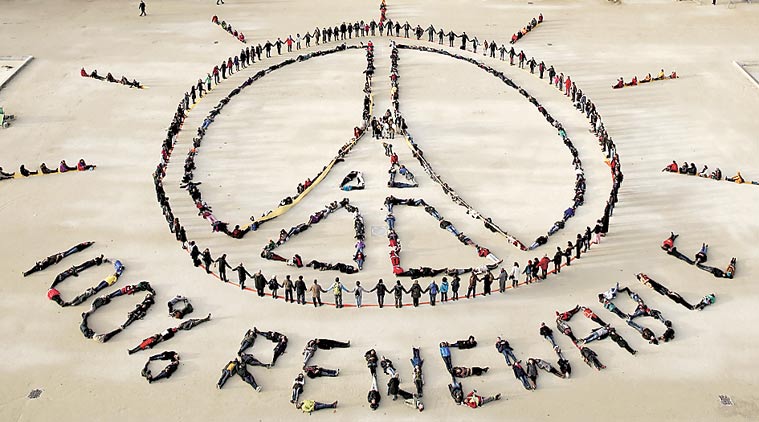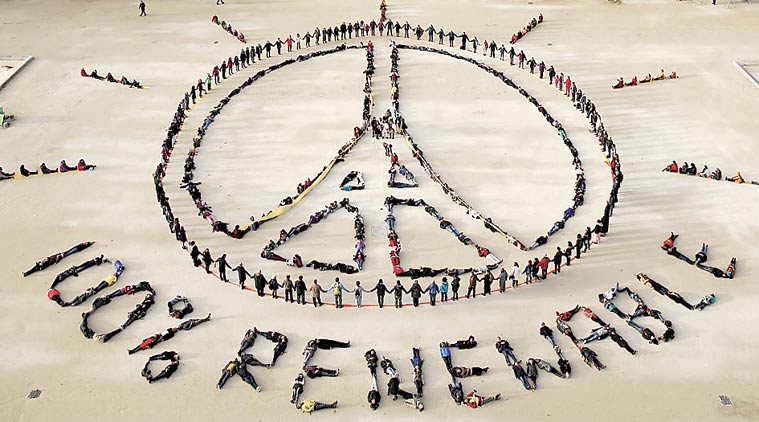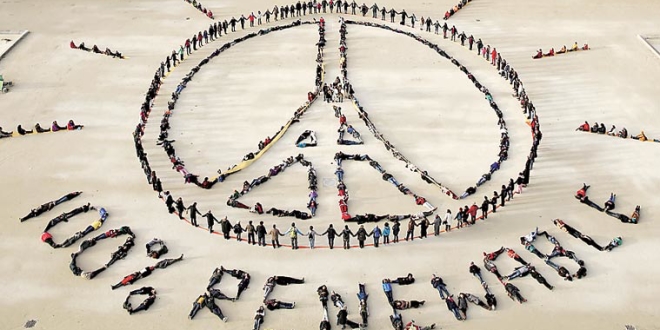
 Environmental activists create a message of hope in Paris. (Source: Reuters)
Environmental activists create a message of hope in Paris. (Source: Reuters)
This month has witnessed two important events whose outcomes point to different conclusions for the future of multilateral cooperation. While the Paris Agreement belied pessimistic expectations and produced a vision for a carbon-neutral future, the outcome of the 10th ministerial conference of the WTO in Nairobi has been expectedly modest, with the underlying political impasse that has hobbled the WTO for over a decade remaining unresolved.
The negotiations for a global response to the challenges of climate change are very different from those in the WTO in terms of their architecture. Despite the hype about the ambitious outcome of COP-21, the goals remain largely aspirational. The Paris Agreement requires commitments only to communicate and maintain plans for reduction of emissions. It does not have a mechanism to penalise non-compliance. Indeed, the agreement expressly provides that the system for ensuring compliance is to be “non-adversarial and non-punitive”. The target for funding ($100 billion per year by 2020) is far from being a bankable commitment. In view of the fuzziness surrounding the implementation of key goals, it is difficult to be optimistic that the vision of a carbon-neutral world before the end of the century can be realised.
Nevertheless, the innovativeness of the five-yearly peer-review process has to be recognised. It should not only enable targets to be continuously reviewed in the light of technological developments as well as more evidence of the relationship between greenhouse gas (GHG) emissions and climate change, but should also enable pressure to be applied on laggards by naming and shaming.
The negotiations under the WTO are substantially different, as their outcomes combine legally binding commitments with an effective system of review and enforcement. The dispute-settlement system of the WTO is widely acknowledged to be fair, efficient and effective. Despite these differences, the key political issue that has bedevilled the two negotiations is the same: That of equity, in terms of the contributions/ commitments to be made by developed and developing countries. The basis for differential treatment in both cases lies in the historical responsibilities of developed countries and the lower capabilities of developing ones. The principles that have been used so far to address this issue are similar: that of common but differentiated responsibilities and respective capabilities (CBDR) in the climate-change negotiations, and of special and differential treatment (S&DT) in the WTO.
The contentiousness around these principles in the current negotiations arises from the remarkable changes in the global economy over the last two decades. China, for instance, has emerged as the largest emitter of GHGs, accounting for around 27 per cent of global emissions. In WTO negotiations, developed countries point to the substantially enhanced role of emerging economies in global trade. These arguments lead to a demand for differentiation between emerging economies and other poorer developing countries. The rebuttal of these arguments is on obvious lines — while such economies may have become competitive in some areas, they continue to struggle with poverty and underdevelopment.
Binary positions cannot lead to binary outcomes in multilateral negotiations. The Paris Agreement marks a compromise — on the one hand, it recognises the CBDR principle as the basis for differential obligations; on the other, it contains no reference to historical responsibilities, thus setting the stage for more equal sharing of the burden in future.
It is doubtful if such a template can be useful in WTO negotiations, given the fundamental difference in the nature of the commitments. It is easier to agree to commitments when they are couched in hortatory language rather than language that will potentially be subject to a judicial process.
The Nairobi outcome portends major changes in the WTO that could bypass the political dispute over S&DT. Ministers have failed to reaffirm the Doha Round, effectively jettisoning it as a “single undertaking”. The stage is now set for rule-making through narrow plurilateral agreements on a number of “new” issues. The Trans-Pacific Partnership, recently finalised among 12 Asia-Pacific nations, including the US and Japan, along with the Transatlantic Trade and Investment Partnership under negotiation between the EU and the US, is likely to provide a template for rule-making in the WTO. These developments have major implications for the role of developing countries in the WTO.
There is little in the Nairobi Declaration to provide comfort to India. The importance of issues like the special safeguard mechanism, as well as the need for a permanent solution on the issue of public stockholding for food security, have merely been reaffirmed, without much progress in the negotiations.
The outcome of the Nairobi ministerial raises a number of challenges for India’s trade policy. A coherent trade policy does not emerge on its own; it is a function of domestic reform and competitiveness. On food security, for instance, India has expended much negotiating capital without exploring adequately the possibility of restructuring its farm-support programmes to conform to Green Box requirements. Such a restructuring will be politically sensitive, but if successfully pursued, would free India to follow other trade objectives. Similarly, India has not pursued, in any meaningful manner, the efficiency gains from domestic market integration in various sectors of the economy, particularly agriculture. The GST is a vital instrument, but there are several other initiatives that require pursuing. Beyond domestic market integration, India’s approach to market integration in the region has been pusillanimous. For instance, a full integration of the textiles and apparel industry in South Asia could lead to significant competitiveness gains, enabling countries in the region to focus on their comparative advantage, thus creating thousands of jobs. The lack of an integrated approach to trade in services is especially striking given India’s global competitiveness in several services. The government’s policy emphasis on “Make in India” is not replicated in services, which has far greater potential for job creation in the economy.
It is only through a forward-looking trade policy based on India’s competitive strengths and a clear vision for the future that India can shape the WTO’s agenda. India’s status as an emerging power in the global economy is not furthered by merely voicing defensive concerns at the WTO.
![]()
Source: New feed






